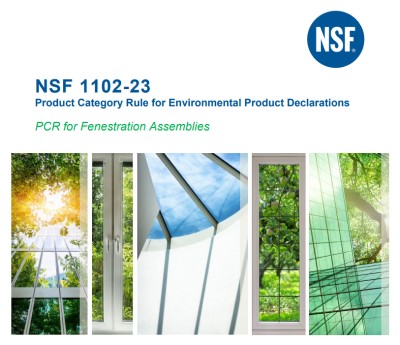A Look at PCR for Fenestration Systems
New PCR for fenestration provides expanded guidelines for supporting environmental product declarations
With owners, architects and organizations’ interest in sustainable products and building practices growing, the newly released Product Category Rule (PCR) for fenestration systems comes at a great time.
Through a collaborative undertaking—spearheaded by the Fenestration and Glazing Industry Alliance, the National Glass Association and the Window & Door Manufacturers Association—the updated and expanded PCR for Environmental Product Declarations (EPDs) has been released.
Informed by third-party verified Life Cycle Assessments (LCAs) within the framework of a PCR, EPDs help building owners, product specifiers and design professionals make accurate product comparisons required by some green building certification programs and a growing number of jurisdictions.
The Importance of a PCR
 “This PCR is important for reporting and standardizing EPD information for fenestration systems,” said Kathy Krafka Harkema, FGIA’s U.S. technical operations director. “It documents the goal and scope of LCAs for this category so that EPDs can be generated according to the applicable ISO standards. Without a well-defined industry PCR, it’s difficult for specifiers, architects, builders and other EPD users to make accurate comparisons in today’s sustainability-conscious world.”
“This PCR is important for reporting and standardizing EPD information for fenestration systems,” said Kathy Krafka Harkema, FGIA’s U.S. technical operations director. “It documents the goal and scope of LCAs for this category so that EPDs can be generated according to the applicable ISO standards. Without a well-defined industry PCR, it’s difficult for specifiers, architects, builders and other EPD users to make accurate comparisons in today’s sustainability-conscious world.”
“The need to improve performance in the built environment is more important than ever,” adds FGIA Technical Training Specialist Aaron Blom.
While the previous PCR only included windows, the latest standard has been expanded to exterior-grade, finished fenestration assemblies including skylights, tubular daylight devices and some door systems, in addition to curtain wall, window wall and storefront systems.
“Formerly known as the Windows PCR, this comprehensive new version more accurately describes the diverse range of fenestration products covered by this standard. This enables it to serve as an even greater and more helpful resource for those interested in using this PCR to develop EPDs as part of a focus on and commitment to sustainability,” said WDMA Vice President of Technical Activities Craig Drumheller.
The new PCR defines a normalized “declared unit” as one square meter of fenestration assemblies for both framing and glass. This accounts for specifiers selecting only the framing or just the glass. The glazing beads and stops, sealants, gaskets and other parts that retain or support the glazing are considered part of the framing assembly and not the glazing assembly.
The relative ratio of framing and glass for EPDs based on the PCR is derived from National Fenestration Rating Council (NFRC) standard sizes and configurations prior to normalization. This may or may not be representative of the project-specific sizes and configurations on a specific building or group of buildings.
While it’s difficult to eliminate any variability in the data with such a comprehensive PCR—including a diverse group of products and how calculations are made—the PCR still offers the most accurate product comparisons currently available.
Stages of the PCR
Specifically, the PCR has been developed to conform with ISO 21930:20171 and only uses the mandatory modules and life cycle stages described in the standard.
The cradle to gate stages, called the construction works life cycle information within the system boundary, are separated into three phases: production, construction and use.
The mandatory production stages include extraction and upstream production, transport to factory and manufacturing. The construction stage includes transport to the jobsite and installation. And the use stage comprises use, maintenance, repair, replacement, operational energy use and operational water use. As part of the maintenance, repair and replacement stages, production, transport and disposal of necessary materials are included.
Mandatory impacts include global warming potential, ozone depletion potential, eutrophication potential, acidification potential and photochemical oxidant creation potential.
Relevant inputs are included in LCA models with the exception of personnel impacts, research and development activities, business travel and any secondary packaging as they represent a negligible environmental impact in the overall life cycle performance of a fenestration assembly.
While the LCA data is often not publicly available because the information is proprietary among fenestration manufacturers, the general findings and assumptions were discussed and accepted by the PCR development team.
As a final note, waste metrics were calculated per ISO 21930:2017. However, these values represent rough estimates and should not be used as actual cradle-gate waste performance between products.


